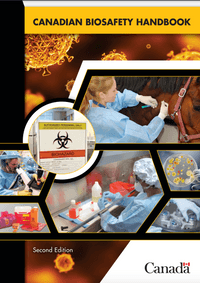
Languages: English, French
Canadian Biosafety Handbook, Second Edition
[Canadian Biosafety Handbook]
The Canadian Biosafety Handbook (CBH) is a companion document to the Canadian Biosafety Standards (CBS). It includes guidance on how to meet the biosafety requirements for safe handling and storing of human and terrestrial animal pathogens and toxins provided in the CBS. The second edition of the CBH is currently being updated to match the third edition of the CBS, which was published in 2022.
SUMMARY
The Canadian Biosafety Handbook (CBH) is a national guidance document that outlines how biosafety and biosecurity requirements from the Canadian Biosafety Standards (CBS) can be attained. The handbook is available in English and in French for free online. It is in the process of being updated to align with the third edition of the CBS which was published in 2022.
The CBH addresses the steps necessary for safe handling and storing of human and terrestrial animal pathogens and toxins in Canada. It provides general guidance for Canadian facilities regarding containment zone personnel rather than specific guidance or standard operating procedures (SOPs) for individual pathogens. The guidelines include: physical containment requirements, operational practice requirements, and performance and verification testing requirements for regulated facilities specified in the CBS.
This resource is part of the Canadian Biosafety Standards and Guidelines set of resources which is maintained as part of a collaboration between Health Canada, Public Health Agency of Canada, and the Canadian Food Inspection Agency.

..png)
